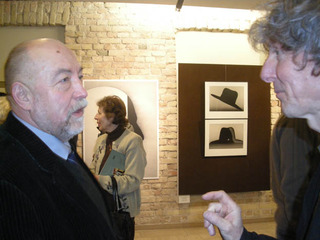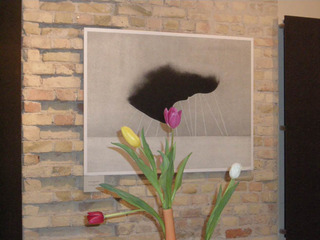| | The Opening of the Exhibition „Silent Cinema“ („The Painted Bird“) |
|
On the 19th of February, 2010, the exhibition „Silent cinema“ („Margas paukštis“), by Polish artist Wieslaw Rosocha was opened at the Tolerance Center of the Vilna Gaon Jewish State Museum.
Mr.Markas Zingeris, Director of the Vilna Gaon Jewish State Museum, and Dr.Malgorzata Kasner, Director of the Polish Institute in Vilnius, have greeted the audience.
Dr. Proffesor Andrzej Zieniewicz from Warsaw‘s University participated in this event and discussed J.Kosinsky‘s authobiografical book „The Painted Bird“.
During the opening ceremony aritist Wieslaw Rosocha explained the creative process of his art. |

|
|
Through Different Eyes
The moment when the laws of the material world stop existing in a work of art we have to look at simple things through different eyes. Then we consciously get closer to the subconscious state of dreaming which enables us to join usual forms into unusual formations.
The exhibition “Silent Cinema” (“The Painted Bird”) by the artist Wieslaw Rosocha who was born in Poland in 1945, continues the traditions of the exhibiting Surrealist artworks at the Tolerance Centre of the Vilnius Gaon State Jewish Museum. In April 2009 an exhibition of photographs by the famous Surrealist artist Man Ray which was held at the Centre showed that the modernist trends of the first half of the twentieth century were still popular with the public. |
 |
At the exhibition “Silent Cinema” (“The Painted Bird”) Surrealist motifs are transferred into contemporary art, or rather, into graphic art and the art of poster. Wieslaw Rosocha graduated from the Warsaw Academy of Fine Arts in 1974 and has earned awards at several international art exhibitions. In 1981 in Warsaw he received the prize for the Best Book Illustration of the Year, in 1985 he received the gold medal at the Sixth International Poster Biennial in Finland, in1986 he was awarded the first prize at the competition for the Best Children’s Book of the Year in Warsaw, in 1991 he won the bronze medal at the International Poster Triennial in Japan, and in 1992 he won the gold medal at the Sixth International Art Directors Club Exhibition in New York. |
|
A Black Sheep
Wieslaw Rosocha’s works inspired by the controversial book “The Painted Bird” by Jerzy Kosinski (1933–1991), which deals with the Holocaust in Poland, are the highlight of the exhibition. The book was published in the US in 1965. Kosinski was born to a Jewish family in Lodz in 1933. His true name was Josek Lewinkopf. During World War II he took refuge with a Polish family under a false identity. In 1957 Kosinski managed to immigrate to the US, where he became an American national in 1965. A graduate of Columbia University, Kosinski devoted his life to art.
His book “The Painted Bird” that inspired Rosocha is a semi-autobiographical novel, which depicts the personal experiences of a boy who wandered through unidentified countries of Eastern Europe during World War II. The people whom he met symbolize the expression of cruelty and violence in society. It is an ambiguous story where the boy (it’s not clear whether he was of a Jewish or Roma background) had to live in a hostile environment and constantly felt like a black sheep among a flock of “painted birds”.
The Shadow of the Wind
Wieslaw Rosocha’s works on display at the exhibition “Silent Cinema” (“The Painted Bird”) are the continuation of exceptionally mastery and undying Surrealist ideas. The influence of the Belgian Surrealist artist Rene Magritte (1898–1967) is clearly seen in his works.
Rosocha adapts Magritte’s favourite recurring motifs: a man in a bowler hat (“Le fils de l’homme” 1964), a woman-fish, the latter turns into a woman-bird or simply man-bird in Rosocha’s works (“L’invention collective” 1934-35), or the motif of an eye so much favoured by Magritte (“The False Mirror” 1928).
In his works Rosocha uses laconic forms, they unify into planes, where blurred contours disappear. Sometimes a vital red stripe appears in a black-and-white colour scheme. Angles are changed, darkness turns into light, anthropomorphic forms become zoomorphic, and the viewer is accompanied everywhere by the unblinking “eye of Rene Magritte”. (Text by Ieva Šadzevičienė).
The exhibition „Silent Cinema“ will be opened until the 23rd of April, 2010. |
|
Photos are from W. Rosocha personal archive | | | Modified: 3/30/2010 |
|
| | | | | Information | | 2017.03.01 | |
|
If you want to order a guided tour or educational programme please contact us in advance:
tel. +370 60163612,
email: muziejus@jmuseum.lt
***
If you want to order an educational programme, please contact us at: +370 5 212 0112,
+370 6 8986 191 or via email muziejus@jmuseum.lt
***
Tolerance Center
(Naugarduko St. 10/2)
working hours:
Monday,Thursday: 10:00-18:00
Tuesday, Wednesday: 10:00-18:00
Friday: 10:00-16:00
Saturday-closed,
Sunday: 10:00-16:00
***
Holocaust Exposition
(Pamėnkalnio St. 12)
working hours:
Monday-Thursday: 9:00-17:00
Friday: 9:00-16:00
Saturday-closed
Sunday: 10:00-16:00
***
Memorial Museum of Paneriai
(Agrastų St. 15, Aukštieji Paneriai)
working hours:
Monday-closed
Tuesday–Sunday 9:00-17:00
From October until May the Memorial Museum is open by appointment only.
If you are interested in visiting the museum/the memorial with a tour guide, please contact us at least a day in advance at
+370 699 90 384 or via email mantas.siksnianas@jmuseum.lt
***
|
|
| | | | | | |  | |  |
|


